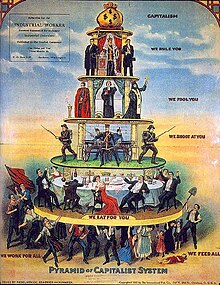Social stratification refers to the society's categorisation of its people into groups grounded on socio-economic factors like wealth, income, race, education, gender, occupation, social status, ethnicity, or deduced power. As similar, stratification is the similar position of persons within a social group, geographic region, order or social unit.
The societies like India, social stratification is generally defined in terms of three social classes the upper class, the middle class and the lower class; in turn each class is then sub classified into the upper-stratum, middle-stratum, and lower-stratum. Also a social stratum can be formed upon the bases of association , clan, lineage, or estate or all four.
The categorisation of people by social stratums occurs more easily in complex state - grounded, polycentric or feudal societies, the ultimate being grounded upon socio-profitable relations among classes of nobility classes of peasants. Whether social position first appeared in huntsman-gatherer, or etnical and band societies or whether it began with husbandry at large- scale means of social exchange remains a matter of debate in the social lores. Determining the structures of social position arises from inequalities of status among persons, thus, the degree of social inequality determines the person's social stratum. Generally, the lesser the social complexity of the society, the further social position exists, by way of social isolation.
Social stratification” is a term used in the social sciences to describe the relative social position of persons in a given social group, category, geographical region or other social unit. It derives from the Latin strātum (plural '; parallel, horizontal layers) referring to a given society's categorization of its people into rankings of socioeconomic tiers based on factors like wealth, income, social status, occupation and power. In modern Western societies, stratification is often broadly classified into three major divisions of social class: upper class, middle class, and lower class. Each of these classes can be further subdivided into smaller classes (e.g. "upper middle"). Social may also be delineated on the basis of kinship ties or caste relations.
The concept of social stratification is often used and interpreted differently within specific theories. In sociology, for example, proponents of action theory have suggested that social stratification is commonly found in developed societies, wherein a dominance hierarchy may be necessary in order to maintain social order and provide a stable social structure. Conflict theories, such as Marxism, point to the inaccessibility of resources and lack of social mobility found in stratified societies. Many sociological theorists have criticized the fact that the working classes are often unlikely to advance socioeconomically while the wealthy tend to hold political power which they use to exploit the proletariat (laboring class). Talcott Parsons, an American sociologist, asserted that stability and social order are regulated, in part, by universal values. Such values are not identical with "consensus" but can indeed be an impetus for social conflict, as has been the case multiple times through history. Parsons never claimed that universal values, in and by themselves, "satisfied" the functional prerequisites of a society. Indeed, the constitution of society represents a much more complicated codification of emerging historical factors. Theorists such as Ralf Dahrendorf alternately note the tendency toward an enlarged middle-class in modern Western societies due to the necessity of an educated workforce in technological economies. Various social and political perspectives concerning globalization, such as dependency theory, suggest that these effects are due to changes in the status of workers to the third world.
Puneet Kumar Goel
B.Tech. Chemical Engg.


Great work
ReplyDeleteThanks
Delete